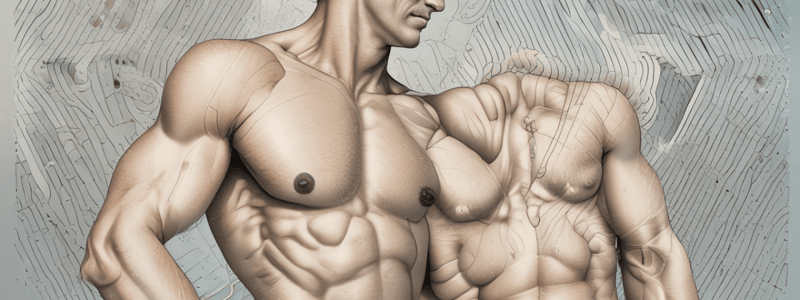Podcast
Questions and Answers
What percentage of men have histological evidence of benign prostatic hyperplasia by the age of 60 years?
What percentage of men have histological evidence of benign prostatic hyperplasia by the age of 60 years?
- 20%
- 50% (correct)
- 30%
- 80%
What is the most common cause of bladder outflow obstruction in men over 70 years of age?
What is the most common cause of bladder outflow obstruction in men over 70 years of age?
- Urinary tract infection
- Benign prostatic hyperplasia (correct)
- Kidney stones
- Carcinoma of the prostate
What is a symptom of voiding in men with benign prostatic hyperplasia?
What is a symptom of voiding in men with benign prostatic hyperplasia?
- Nocturnal incontinence
- Dysuria
- Hesitancy (correct)
- Increased frequency
What is a complication of bladder outflow obstruction?
What is a complication of bladder outflow obstruction?
At what age is carcinoma of the prostate most common?
At what age is carcinoma of the prostate most common?
What is a indication for prostatectomy in men with benign prostatic hyperplasia?
What is a indication for prostatectomy in men with benign prostatic hyperplasia?
What is a cause of acute retention in men with benign prostatic hyperplasia?
What is a cause of acute retention in men with benign prostatic hyperplasia?
What is a lower urinary tract symptom in men with benign prostatic hyperplasia?
What is a lower urinary tract symptom in men with benign prostatic hyperplasia?
What is the most common site of origin for skeletal metastases?
What is the most common site of origin for skeletal metastases?
What is often the first symptom of prostate cancer?
What is often the first symptom of prostate cancer?
What is the primary treatment for localized prostate cancer?
What is the primary treatment for localized prostate cancer?
What is the most common organism responsible for acute prostatitis?
What is the most common organism responsible for acute prostatitis?
What is the term for a blockage in the flow of urine?
What is the term for a blockage in the flow of urine?
What is the term for the examination of the prostate gland through the rectum?
What is the term for the examination of the prostate gland through the rectum?
What is the term for a measure of the severity of prostate cancer?
What is the term for a measure of the severity of prostate cancer?
What is the first-line therapy for advanced prostate cancer?
What is the first-line therapy for advanced prostate cancer?
Flashcards are hidden until you start studying
Study Notes
Benign Prostatic Hyperplasia (BPH)
- BPH occurs in men over 50 years old, with 50% of men showing histological evidence by the age of 60.
- Lower urinary tract symptoms (LUTS) associated with BPH include:
- Voiding symptoms: hesitancy, poor flow, intermittent stream, and dribbling
- Storage symptoms: frequency, nocturia, urgency, urge incontinence, and nocturnal incontinence
- BPH is the most common cause of bladder outflow obstruction in men over 70 years old.
Management of Men with BPH or Bladder Outflow Obstruction
- Acute retention in fit men without other causes (e.g., drugs, constipation, recent operation)
- Chronic retention and renal impairment: residual urine of 200 mL or more, raised blood urea, hydroureter, or hydronephrosis
- Complications of bladder outflow obstruction: stone, infection, and diverticulum formation
- Haemorrhage: venous bleeding from a ruptured vein overlying the prostate may require prostatectomy
- Elective prostatectomy for severe symptoms: increasing difficulty in micturition, frequency, and poor stream
Carcinoma of the Prostate
- Carcinoma of the prostate is the most common malignant tumor in men over 65 years old
- Screening for prostate cancer involves measurement of PSA (prostate-specific antigen)
- Local spread: locally advanced tumors tend to grow upwards to involve the seminal vesicles, bladder neck, and trigone
- Spread by the bloodstream: particularly to bone, with the pelvic bones and lower lumbar vertebrae being the most frequently involved sites
Presentation and Clinical Features of Prostate Cancer
- Men are often asymptomatic, with detection occurring through opportunistic PSA testing
- Cancer may be detected in men describing lower urinary tract symptoms or presenting with symptoms of metastatic disease
- Clinical features: BOO, pelvic pain, haematuria, bone pain, malaise, ‘arthritis’, anaemia, pancytopenia, and renal failure
Treatment and Stage of Prostate Cancer
- Treatment options depend on stage of disease, life expectancy, and patient preference
- Prostate-specific antigen, digital rectal examination, and biopsy Gleason grade are used to predict pathological stage
- Localized cancer can be treated by radical prostatectomy, radiation therapy, and active monitoring
- Treatment of advanced disease is palliative, with hormone ablation being the first-line therapy
Prostatitis
- Acute prostatitis is common but underdiagnosed
- Usual organisms responsible: Escherichia coli, Staphylococcus aureus, Staphylococcus albus, Streptococcus faecalis, Neisseria gonorrhoeae, or Chlamydia
- Infection may be haematogenous from a distant focus or secondary to acute urinary infection
Studying That Suits You
Use AI to generate personalized quizzes and flashcards to suit your learning preferences.




